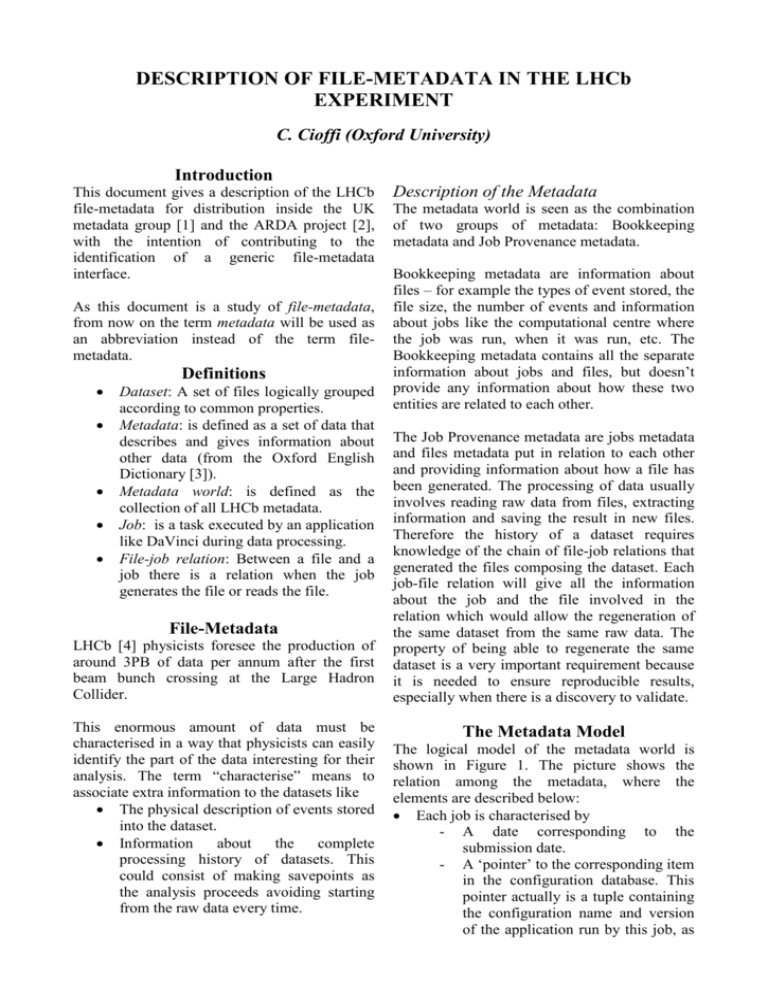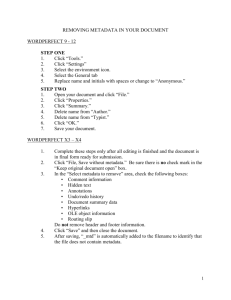doc
advertisement

DESCRIPTION OF FILE-METADATA IN THE LHCb EXPERIMENT C. Cioffi (Oxford University) Introduction This document gives a description of the LHCb file-metadata for distribution inside the UK metadata group [1] and the ARDA project [2], with the intention of contributing to the identification of a generic file-metadata interface. As this document is a study of file-metadata, from now on the term metadata will be used as an abbreviation instead of the term filemetadata. Definitions Dataset: A set of files logically grouped according to common properties. Metadata: is defined as a set of data that describes and gives information about other data (from the Oxford English Dictionary [3]). Metadata world: is defined as the collection of all LHCb metadata. Job: is a task executed by an application like DaVinci during data processing. File-job relation: Between a file and a job there is a relation when the job generates the file or reads the file. File-Metadata LHCb [4] physicists foresee the production of around 3PB of data per annum after the first beam bunch crossing at the Large Hadron Collider. This enormous amount of data must be characterised in a way that physicists can easily identify the part of the data interesting for their analysis. The term “characterise” means to associate extra information to the datasets like The physical description of events stored into the dataset. Information about the complete processing history of datasets. This could consist of making savepoints as the analysis proceeds avoiding starting from the raw data every time. Description of the Metadata The metadata world is seen as the combination of two groups of metadata: Bookkeeping metadata and Job Provenance metadata. Bookkeeping metadata are information about files – for example the types of event stored, the file size, the number of events and information about jobs like the computational centre where the job was run, when it was run, etc. The Bookkeeping metadata contains all the separate information about jobs and files, but doesn’t provide any information about how these two entities are related to each other. The Job Provenance metadata are jobs metadata and files metadata put in relation to each other and providing information about how a file has been generated. The processing of data usually involves reading raw data from files, extracting information and saving the result in new files. Therefore the history of a dataset requires knowledge of the chain of file-job relations that generated the files composing the dataset. Each job-file relation will give all the information about the job and the file involved in the relation which would allow the regeneration of the same dataset from the same raw data. The property of being able to regenerate the same dataset is a very important requirement because it is needed to ensure reproducible results, especially when there is a discovery to validate. The Metadata Model The logical model of the metadata world is shown in Figure 1. The picture shows the relation among the metadata, where the elements are described below: Each job is characterised by - A date corresponding to the submission date. - A ‘pointer’ to the corresponding item in the configuration database. This pointer actually is a tuple containing the configuration name and version of the application run by this job, as given in the configuration database. A query on the configuration database will thus yield a description of the job configuration, including the default job options - A set of parameters, given as name/value/type triplets that characterise the job. Examples of the use of parameters are the production location, the run number (if any) and the version of the detector geometry used. Examples of parameter types are “environment variable” or “info”. - A set of input files and a set of output files Each file is characterised by - A logical name. This name is not a file name by itself, but a means of retrieving the file using the File Catalogue - A file type. - A set of quality flags. - A set of parameters that characterise the file. Examples of parameters are the file size and the master copy of the file in the case of a distributed environment. If the file is a data file, more parameters may be defined such as the number of events in the file and the event type or a pointer to the master copy of this file. A File Type, which describes the content of a file, is characterized by - A name (RAW, DST, Log, Tag Collection, etc.). - A version, usually a number. Note that in this schema, DST2 is not a type. DST is the type and 2 is the version. - A set of parameters, if more details are needed. An example is a short description of the type. A Quality, which is used to tag a file as useful for a given analysis, is characterized by - A group, which is the type of analysis or the group of people concerned by this quality. Examples are “Production Manager” or “Calo”. - A flag, which is the actual quality. Values of this field are “Good”, “Fair”, “Bad” and “Not checked”. - A set of parameters if more details are needed. An example may be the validity of the quality flag. The recursive job-file relation is also shown in Figure 1. For LHCb this recursion has a maximum depth of three as illustrated in Figure 2. This figure shows furthermore that a file is the output of one job and that a job can have many files as input. Storing Metadata A very brief description of how metadata are stored is helpful for a better understanding of the distinction and the relation between Bookkeeping metadata and Job Provenance metadata. For more information on the metadata database refer to [5]. Database Schema All metadata are stored in a relational database from which schema it is possible to extrapolate the distinction between Bookkeeping and Job Provenance metadata. The database organization was dictated more by the software applications need than by the logical distinction between Bookkeeping metadata and Job Provenance metadata. However, the distinction between these two groups of metadata is still visible in the database schema. The database is characterised by two schemas one called Warehouse schema and the other one called Specialised View schema (Figure 3). From the Warehouse schema, it is possible to see how it has been designed around the two main entities of Jobs and Files. For each of these two entities, there are some more satellite entities (JobParams, FileParams, etc) which are intended to keep some extra information about the jobs and the files. This schema without the “input output” relation could be used as the schema for the storage of just the Bookkeeping metadata. The “input output” relation is the representation of the job-file relation, and it is thanks to it that it is possible to build the complete history of a file. The Specialised View schema is design to give information about the provenance of a file in a performant manner; in essence it provides the history of a file ready to be read without the need to build it from the Warehouse DB. The entity Job Summary has attributes (like Config, Inputfile2, etc.) that put in relation a file A of type “Inputfile0” to the job that created it (Program0) which had as input files of type Inputfile1 produced by “Program1”. So, this entity tells us how the file A has been generated starting from files of type Inputfile2 or Inputfile1 including information about the intermediate process. Use Cases In this section, a list of LHCb use cases is given. The use cases are grouped on the basis of their common property of reading or modifying the metadata DB and they are a subset of all the use cases known to date. They represent the atomic use cases that are combined together to satisfy all the known LHCb physicist use cases. The Use Cases list Reading use cases: Get the list of all jobs. Get all the jobs executed during a given interval of time. Get all the jobs having a given configuration. Get the job that generates a file. Get a job given its id. Get the list of all files. Select files based on a SQL query. Get the files that have been input of a job. Get the files that have been the output of a job. Get all the file of a given type. Get the qualities of a file. Get the qualities of a file with a specified group and flag property. List all the file types. Get the file type with a given name and version. Get the type of a file. Get the parameters of a job. Get the parameters of a job with a specified type. Get the parameter of a job with a specified name. List the quality parameters of a quality. Get the quality parameter of a quality with a specific name. List the parameters of a file. Get the parameter of a file with a specified name. List the parameters of a Type. Get the parameter of a type specified by a name. List all the configurations. List all file types for a given configuration. List all the centres where the files of a given type and configuration are located. Get the total number of events available at a centre for files of a specific type and configuration. Get the history of the files of a specific type and configuration. This is the chain of file-job relations that generated them, starting either from the raw data produced by the detector or from the simulated data in case of Monte Carlo Production Write use cases: Create a job. Change the configuration of a job. Change the configuration version of a job. Change the date of a job. Delete a job. Create a file. Modify the logical name of a file. Delete a file. Create a quality for a file. Delete a quality. Create a type. Delete a type. Create a job parameter of a file. Modify the parameter value of a job. Modify the parameter type of a job. Delete a job parameter. Create a file parameter. Modify the parameter value of a file. Delete the parameter of a file. Create a quality parameter for a quality. Modify the quality parameter of a quality. Delete a quality parameter. Create a type parameter. Modify the value of a type’s parameter. Delete a type’s parameter. Add files to the list of job’s input files. Remove a file from the list of job’s input files. Conclusion From the analysis of the metadata world it is clear that the Bookkeeping metadata are a subset of the Job Provenance metadata where any information about the relation between files and jobs is missing. This peculiar aspect of the metadata world must be kept in mind in the design of the HEP metadata interface that could encapsulate the LHCb use cases. So, we expect to see an interface that allows the management mainly of the Bookkeeping metadata and has a flexible syntax that at same time allows operating on the job-file relation. In a relational database, it is possible to collect all information about the jobfile relation thanks to the join operation based on the “input/output” relation (see Figure 3). In the same way, we expect to see a method or a set of methods in the metadata interface that allow the collection of all the information about the process history of a dataset. References [1] http://www.gridpp.ac.uk/datamanagement/ metadata [2] http://project-arda-dev.web.cern.ch/ project-arda-dev/metadata [3] http://dictionary.oed.com [4] LHCb, S. Amato et al, LHCb Technical Design Report, CERN-LHCC-2003-030, September 2003. [5] http://lhcb-doc.web.cern.ch/lhcb-doc/ presentations/conferencetalks/postscript/ 2004presentations/ CarmineCioffiCHEPbookkeepingPaperNote.doc







